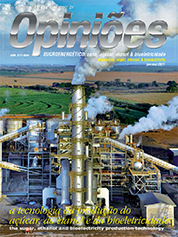Florenal Zarpelon
Director of FZ Consultoria Industrial
Op-AA-27
Ethanol distillation in Brazil
In Brazil, a typical modern sugar mill converts extracted sugars into approximately 50% of sugar and 50% of ethanol, and is optimized to produce electric power for sale, efficiently exploring the energy contained in the bagasse. This energy optimization implies reducing to the maximum degree the domestic consumption of mechanical, electric or thermal energy, along with the consumption of steam from the process, i.e., exhaust steam, to allow for maximum generation in condensation.
Hence, each process must be improved to make better use of the resources needed to comply with what nowadays is called Sustainability. Interestingly, for a long time we have experienced the need to increase efficiency in using energy and apparently this is perpetual, to the extent that broadening knowledge makes us discover that there is always room to improve.
The distillation of ethanol, an important step in the production process, is a unit operation that intensively uses energy, consuming steam, electric power and water, while generating a considerable volume of liquid effluent – vinasse – that with a high biochemical oxygen demand (BOD), results in even more energy consumption, due to distribution on the sugarcane fields or the treatment process, the solution of which can as yet not be seen as totally achieved.
Our distillation technology follows a conventional approach, in which the columns are designed to operate at atmospheric pressure, resulting in operational simplicity. So, we lose opportunities to improve steam consumption. Our technology is not bad, but we could still improve. First of all, one should remember that the distillation column (column A or C-10) is responsible for the consumption of approximately 75% of the steam consumed in the production of hydrous ethanol. Hence, it would be the first to be improved.
The first step is to increase the beer temperature to that of the inlet plates, or, at least to 90ºC, roughly each 5ºC increase in the beer temperature represents a reduction in steam of 0.1 kg/l of ethanol. This is accomplished by improvements to the “beer heating” condenser and the beer-vinasse heat exchanger, thus making use of some of the heat that will be lost.
Another 0.1 kg/l of steam consumption reduction is obtained by isolating the distillation column, and somewhat more by also isolating the rectifying column. To increase alcohol content in the beer, say by 2 percentage points, from 10 to 12% v/v, represents a reduction in total steam consumption of approximately 15%. If we achieve 3 percentage points, the reduction will be of 20%.
If the rectifying column operating at atmospheric pressure represents steam consumption of only 25% of the total, there is little to gain. However, the increase in space between plates which is already being undertaken, and the improvement of downcomers to also prevent entrainment of alcoholic vapors (“multijet” effect) allows to reduce the needed reflux ratio, resulting in a reduction of steam consumption or even an increase in capacity.
Improvements to the rectifying column condensers has good operational impact, resulting in less pressure in the top of the column and therefore, allowing for operating the column with less pressure. The first condenser of the rectifying column, the “beer heater”, must heat the beer to at least 70ºC, so that the final heating is above 90ºC.
Outside conventional technology, a good alternative is to operate a distillation column under vacuum. Obviously, such a column needs to be re-designed, given that the diameter and the wall thickness increase significantly due to the vacuum. The first advantage of operating under vacuum is to avoid scaling in the column, yet now we want to increase the beer's alcohol content, because, as we know, calcium salts are more soluble at lower temperatures.
When we produce anhydrous alcohol by the azeotropic process, a good alternative to consume steam as least as possible in dehydration is to design the dehydration column to operate under vacuum, and to use some of the hydrous alcohol vapors from the rectifying column, which also decreases water consumption in the rectifying condensers.
International consulting companies claim for other systems, operating the distillation column under higher pressure, or the rectifying using steam at 10 bar which is not available in a mill. Many of the proposed systems are actually quite interesting, but it is often forgotten that the production of ethanol in Brazil is integrated with that of sugar, and that certain solutions are inadequate for local conditions. Experience achieved in industrial practice is valuable and when combined with sound engineering helps quite considerably. Therefore, although the proposals are interesting, they should be carefully analyzed.
Concerning to the reduction of electric energy, passing the water in series in the condensers allows the reduction of water flow, i.e., the energy for pumping the water and besides this as the flow passing through each condenser increases this causes an increase of the overall heat transfer coefficient and thus the capacity of the condensers. This is an example of improvements that can be done easily and that could be consolidated into the Brazilian distillation technology to compare to what best exists in the international market.




